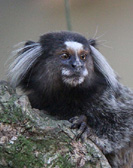Get
To Know
|
 Wied's Marmoset is a New World monkey that lives in lowland
and sub-montane humid forest, seasonal rain forest, and white sand
piašava forest of eastern Brazil. They are also known to use cacao
plantations which are shaded with some native trees remaining from
the original forest, and secondary growth forest in abandoned rubber
plantations. They eat fruits, flowers, nectar, plant exudates (gums,
saps, latex) and animal prey (including frogs, snails, lizards,
spiders and insects). They gouge trees trunks, branches and vines
of certain species to stimulate the flow of gum, which they eat,
and in some species form a notable component of the diet. Since
these are harvested from the middle and lower part of the forest,
they often travel and forage in the company of the golden-headed
lion tamarin, which is also foraging in the canopy. The coloring
of Wied's marmoset is mostly black, with white markings on cheeks
and forehead. It has rings on its tail and black tufts of fur coming
out of its ears. They are distinguished from the other monkeys of
the New World by their small size, modified claws rather than nails
on all digits except the big toe, the presence of two as opposed
to three molar teeth in either side of each jaw, and by the occurrence
of twin births. Unlike other marmosets, they lives in groups consisting
of 4 or 5 females and 2 or 3 males (plus children). They are matriarchal,
and only the dominant female is allowed to mate. They are highly
social, spending much of their time grooming. They have individually
distinctive calls, and also communicate through gestures and olfactory
markings. The groups defend home ranges 10-40 hectares, the size
depending on availability and distribution of foods and second-growth
patches. They are currently listed as Near Threatened as they are
believed to have experienced a decline in the order of 20-25% over
the past 18 years primarily as a result of habitat loss. They are
also eaten by birds of prey (the harpy eagle, the gray hawk, the
roadside hawk and the white-tailed hawk), felines (the jaguar, jaguarundi
and ocelot) and snakes. Since it is rather adaptable to anthropogenic
disturbance, declines are unlikely to be such that the species would
require listing in a threatened category.
Wied's Marmoset is a New World monkey that lives in lowland
and sub-montane humid forest, seasonal rain forest, and white sand
piašava forest of eastern Brazil. They are also known to use cacao
plantations which are shaded with some native trees remaining from
the original forest, and secondary growth forest in abandoned rubber
plantations. They eat fruits, flowers, nectar, plant exudates (gums,
saps, latex) and animal prey (including frogs, snails, lizards,
spiders and insects). They gouge trees trunks, branches and vines
of certain species to stimulate the flow of gum, which they eat,
and in some species form a notable component of the diet. Since
these are harvested from the middle and lower part of the forest,
they often travel and forage in the company of the golden-headed
lion tamarin, which is also foraging in the canopy. The coloring
of Wied's marmoset is mostly black, with white markings on cheeks
and forehead. It has rings on its tail and black tufts of fur coming
out of its ears. They are distinguished from the other monkeys of
the New World by their small size, modified claws rather than nails
on all digits except the big toe, the presence of two as opposed
to three molar teeth in either side of each jaw, and by the occurrence
of twin births. Unlike other marmosets, they lives in groups consisting
of 4 or 5 females and 2 or 3 males (plus children). They are matriarchal,
and only the dominant female is allowed to mate. They are highly
social, spending much of their time grooming. They have individually
distinctive calls, and also communicate through gestures and olfactory
markings. The groups defend home ranges 10-40 hectares, the size
depending on availability and distribution of foods and second-growth
patches. They are currently listed as Near Threatened as they are
believed to have experienced a decline in the order of 20-25% over
the past 18 years primarily as a result of habitat loss. They are
also eaten by birds of prey (the harpy eagle, the gray hawk, the
roadside hawk and the white-tailed hawk), felines (the jaguar, jaguarundi
and ocelot) and snakes. Since it is rather adaptable to anthropogenic
disturbance, declines are unlikely to be such that the species would
require listing in a threatened category.
|
|
|
|
Jessie Refers to Herself as a Housewife
by
John Grey
Living is compulsion and pain.
To live, to really live,
is to act on impulse
and suffer the consequences.
How my sister gets through her day
is something else entirely.
She denies her addictions and obsessions
no matter how much they define
what I once loved about her.
She turns away from life,
never does what she wants,
blandly accepts the feel-good nonsense
that comes with that.
And yet she's
as compulsive, as in pain,
as the rest of us.
Yes, she has tried
to compromise herself
into submission.
But the truth
can only have so many babies,
clean so many floors,
prepare so many meals.
It may be between her and
those denuded fingernails,
but she is in agony.
The difference is that
my suffering gets the chance
to air itself out once in a while.
Hers is trapped on the inside.
Denial is uppermost.
On her face, a smile
does the work of a lie.
So that's how it stands.
I do dumb things and I pay for it.
She does dumb things
and it's a trade secret.
John Grey is an Australian poet, US resident. Recently published in Schuylkill
Valley Journal, Stillwater Review and Big Muddy Review with work upcoming
in Louisiana Review, Columbia Review and Spoon River Poetry Review.
|
 Wied's
Marmoset - Issue Twenty-Nine
Wied's
Marmoset - Issue Twenty-Nine